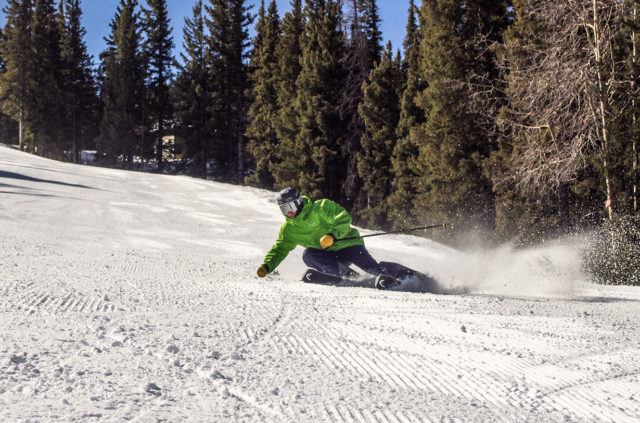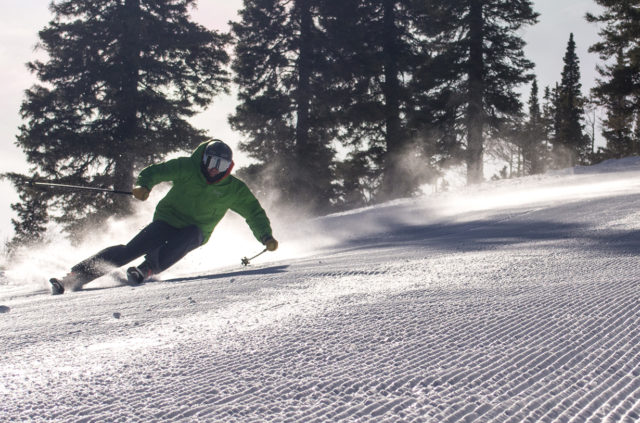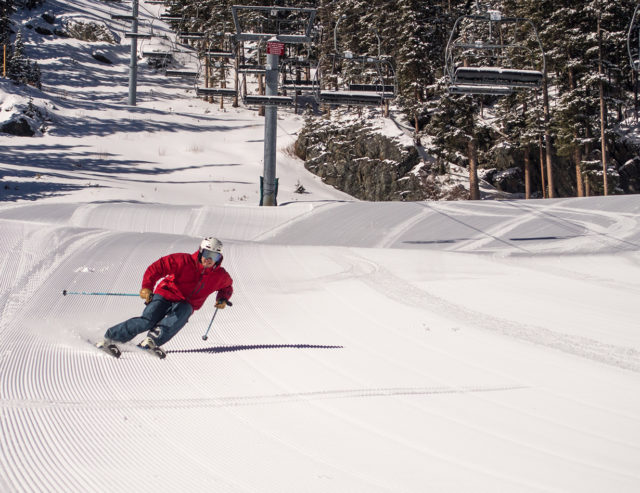Ski: 2019-2020 Head Supershape i.Titan, 177 cm
Available Lengths: 156, 163, 170, 177 cm
Blister’s Measured Tip-to-Tail Length: 175.3 cm
Blister’s Measured Weight per Ski: 2320 & 2359 grams
Stated Dimensions: 138-81-118 mm
Blister’s Measured Dimensions: 137.6-80.1-117.2
Stated Sidecut Radius: 15.0 meters
Measured Tip & Tail Splay (ski decambered): 59 mm / 12 mm
Measured Traditional Camber Underfoot: ~2 mm
Core: Fir + Titanal (2-layers) + Fiberglass Laminate
Base: RD Race Structured UHM C Base
Factory Recommended Mount Point: N/A (sold with binding plate)
Boots Used: HEAD Raptor 140 RS; Dalbello Lupo SP I.D.
Bindings Used: Head PRD 12 GW
Test Locations: Taos Ski Valley, NM; Arapahoe Basin, CO
Days Skied: 6
[Note: Our review was conducted on the 18/19 Supershape i.Titan, which was not changed for 19/20, apart from graphics.]

Intro
We’ve been talking about the Head Supershape i.Titan quite a bit — it got a Best Of award in our 18/19 Winter Buyer’s Guide, we’ve discussed it on our GEAR:30 podcast, and I mentioned it in my 3-ski-quiver selections.
But now it’s time to go a bit deeper with a full review and flesh out why we’re so high on this carving ski from Head. But first…
What we said about the Supershape i.Titan in our 18/19 Winter Buyer’s Guide:
“If your priority is carving medium and larger turns on ice (or any surface, actually), this is one of our favorites. The i.Titan feels remarkably damp and planted, and carves extremely well across all on-piste conditions. It is quite similar in feel to the Supershape i.Rally, but the i.Titan has a bigger top end and a bit more energy. So our advice is to ignore the width differences and focus on our performance descriptions. The i.Titan is less versatile in terms of turn shape than the Head Monster 83, but few skis we’ve been on so easily and predictably let you initiate high-angle arcs without yanking you into a turn. In that sense, while this is a serious and seriously good ski, Head could have called it the i.Trainer, since intermediates won’t get punished by this high-performance ski that experts will love.”

Shape / Rocker Profile
The i.Titan has a pretty standard shape for a groomer ski, though it’s worth noting that Head’s Supershape skis have about as little taper as is physically possible — the sidecut extends to almost the very end of the ski at the tips and tails.
When it comes to rocker, well … there really isn’t any. The i.Titan is a good-ole-fashioned fully cambered ski. You get a raised tip and a very slightly upturned tail, but almost the entire length of the ski is touching the snow when tipped on edge.
Flex Pattern
Here’s how we’d characterize the longitudinal flex pattern of the Supershape i.Titan:
Tips: 8.5-9
Shovels: 9.5
In Front of Toe Piece: 9
Underfoot: 9
Behind Heel Piece: 9-8.5
Tails: 9-9.5
For how intuitive this ski is (we can recommend it to intermediates), it does have a very strong longitudinal flex pattern.
[Note: If you are wondering why we are talking about the longitudinal stiffness of this ski, keep reading, but we will later talk about the torsional stiffness of this ski.]
No part of the i.Titan is particularly soft, and interestingly enough, the midsection is not the stiffest part of the ski. That said, the i.Titan can be bent along its entire length, it just takes a bit of force to do so (i.e., it’s not an unbendable 2×4).
Compared to the Head Supershape i.Rally, the i.Titan is very slightly stiffer in the back half, but the two skis feel basically identical in their front halves.
Compared to the Head Monster 83 Ti and Monster 88 Ti, the i.Titan has a slightly stiffer shovel, but the skis’ flex patterns are all very similar.
Dimensions / Sidecut Radius
The i.Titan falls slightly on the wider end of the spectrum for dedicated carvers, with a waist width of ~80 mm. That said, it’s still far from fat by today’s standards.
With a 15 m stated sidecut radius for the 177 cm version, the i.Titan has a slightly tighter sidecut than skis like the Head Monster 83 (16.7 m) and K2 Ikonic 84 Ti (17.5 cm), but the sidecut of the i.Titan isn’t approaching slalom-ski territory like the DPS Cassiar A79 (12.5 m).
Weight
For reference, here are a few of our measured weights (per ski, in grams) for some notable skis. As always, keep in mind the length differences to keep things apples-to-apples.
1647 & 1708 Liberty V76, 179 cm (18/19)
1777 & 1792 Liberty V82, 179 cm (18/19)
1936 & 1942 Head Monster 83 Ti, 177 cm (18/19)
2077 & 2092 K2 Ikonic 84 Ti, 177 cm (17/18, 18/19)*
2166 & 2167 Dynastar Speedzone 12 Ti, 182 cm (17/18, 18/19)*
2279 & 2299 Head Supershape i.Rally, 177 cm (17/18, 18/19)*
2317 & 2323 K2 Super Charger, 175 cm (17/18, 18/19)*
2320 & 2359 Head Supershape i.Titan, 177 cm (17/18, 18/19)*
2336 & 2350 Fischer RC4 The Curv GT, 175 cm (17/18, 18/19)*
2414 & 2516 Head Worldcup Rebels i.Speed Pro, 180 cm (17/18, 18/19)*
2489 & 2498 Fischer RC4 The Curv, 178 cm (17/18, 18/19)*
*includes weight of binding plates
Now here is Sam Shaheen’s and my take on the performance of the i.Titan:
Groomers
Sam Shaheen (5’10”, 140 lbs): Some frontside skis don’t have many (or any) stand-out characteristics. However, the i.Titan has a distinct on-snow feel — this ski feels smooth. Yes, it holds a strong edge, feels powerful (while still being quite forgiving), and feels comfortable at speed. But overall, the i.Titan just feels smooth. It is incredibly damp and sucks up little bumps, icy patches, and other inconsistencies in the snow with surprising ease.

Though the i.Titan has a relatively tight sidecut radius (15 m), it feels most comfortable making medium to larger radius turns. I could bend the ski into tighter turns, but it took a lot of energy, and it sometimes felt like I was fighting the ski to do so.
One of the more impressive things about this ski is how well it holds an edge on ice and firm snow. The smooth, damp nature of the ski makes it feel very planted and confidence inspiring on hard snow. This, combined with the fact that the i.Titan is still quite forgiving, makes it one of my top choices when it comes to firm, icy groomers.
Jonathan Ellsworth (5’10”, 175 lbs): I generally dislike admitting that Sam is right, but here, he is. So the biggest thing I want to do is expand a little on all of this talk of his (and mine) about how forgiving this ski is.
Given the weight of this ski and its strong flex pattern and the ice-scraper shape of its tail and that oversized tip … you’d have every reason in the world to assume that the i.Titan would demand of you complete focus all of the time — or else. But we haven’t found that to be true at all.
Sometimes, skis this strong will really punish and throw you if you happen to finish a hard, carved turn with your weight a bit too far back. Or, if your attention wanders, skis that have such oversized tips may rip you hard across the fall line when you aren’t really expecting or intending them to do so. But I can’t remember a single turn on the i.Titans where I experienced that. So to have a ski that is so conducive to carving hard, yet is so ready and willing to initiate a turn … and then, won’t penalize you for small mistakes? Cool.
That said, if you are looking for a ski that really sucks you into a turn right away (which can certainly be fun), then this might not be the ski for you. The i.Titan is all about the easy, intuitive, and smooth initiation of turns, not the instant engagement of turns.
Stability at Speed
Sam: Of all of the frontside skis I’ve been on, the i.Titan is one of the most stable at speed, mostly due to its damp feel. It doesn’t feel super stiff, but the fact that the ski smooths out everything in its path makes it feel happy charging at high speeds on groomers.

To be clear though, this isn’t just an ex-racer / expert-only frontside tool. I think intermediates through experts will all get along well with this ski. It is very stable at speed, but it is also happy sliding around turns at moderate speeds. And when the ski does get put on edge, it doesn’t feel locked into the turn like many frontside skis. It’s easy to break free and slide, which intermediates will appreciate.
Jonathan: Yep. And this is why I said in our Buyer’s Guide that you could call the i.Titan the i.Trainer. There are a number of skis that look fairly similar to the i.Titan that I would not feel comfortable putting an intermediate skier on. But if I’m asked what ski is a good tool for helping someone learn to use their edges and start getting comfortable with hard, aggressive carves, this is my current answer.

Bumps / Trees / Off-Piste
Sam: The i.Titan is certainly best suited for skiing groomers. Off-piste, the ski feels heavy, cumbersome, and out of place. The wide, hammerhead-shaped tips, tight sidecut radius, traditional mount point, and lack of rocker all scream “groomer ski.” Though not impossible to take off-piste, there are a zillion better options if you want your frontside ski to also be fun in trees, moguls, and variable snow.
Jonathan: Yeah, I’m not taking these off-piste. Can you? Sure. But is there anything about the design of this ski that is optimized for skiing ungroomed snow down uneven terrain? No. Nothing.
Torsional Stiffness / Engineering Food for Thought
This is important, and it certainly seems to be a key part of the secret sauce of the i.Titan.
When we were working with Alexis Lussier Desbiens from the University of Sherbrooke analyzing flex patterns of skis, Alexis replied to my comments about the on-snow performance characteristics of the i.Titan with this:
“Your comments about the i.Titan are in line with what we have been measuring. We noticed something “strange” about Head’s skis since we started our measurements three years ago. Although we haven’t measured all of their skis, we noticed a very low torsional stiffness in the SuperShape products. From an engineering point of view, it is impressive how much they can reduce the torsional stiffness of these skis … compared to a similarly shaped slalom ski and to the Head Monster 108. Bending stiffness is about the same in all of these skis, but torsional stiffness is highly different. We’ve never seen skis with such low torsional stiffness, and the description that you make of the i.Titan is exactly our running hypothesis of what low torsional stiffness does to a ski: a ski that is surprisingly versatile and agile, that is not locked into a turn, etc.”
It’s always nice to see lab results in line with what we’ve found out on the mountain.
Who’s It For?
Intermediates looking for a ski that will really allow them to up their carving game, and experts who want a smooth, powerful, and predictable carver (as opposed to a lighter, more reactive, extremely high-energy carver) that is extremely good on ice, chunky, roughed-up groomers, slush … and even perfect corduroy.
Bottom Line
The Head i.Titan is for anyone who wants to either learn to put a ski on edge, or someone who wants to spend most of their day making high-edge-angle turns. Anyone from intermediates to experts looking for a dedicated carving tool should definitely consider the i.Titan.



I’m glad you’re doing some groomer skis because no quiver is complete without a dedicated race carver type stick. You should check out CROC also called Augment skis! They’re brand new, small production, and also in the Austrian ski pool. They make a beautiful masters race ski for both GS and SL. I would love to read a review from one of your ex-racer testers. Just a thought.
Great review! These are my “go-to” groomer zoomers these days. At 6’2″ and 195 pounds, the only flaw I find in them is that Head doesn’t offer a 182 cm length.
I have a great time with them in bumps, but again, I’m a fair bit heavier than you two, and these days, my knackered knees only like bumps taken at moderate speeds, following the smoothest path offered, so take the bump comment for what it’s worth.
At 6’3″ 220 i found the 177 too short. great ski, but too short – actually closer to 175. Went with the Rossi elite Hero Plus at 181 which hand flexes as stiffer than the titan. Have had great experiences with the heros having skiied in a number of them including owning the hero master r21 which is a beast.
Tired of polishing lava off-piste and core shots taking on water I ended up with a pair of these last season. Don’t overthink these if low tide conditions are keeping you on-piste more than usual. These are not a watered down race ski you may not want to be on all day as conditions and temperatures change. The Titan has a huge bandwidth between relaxing, all-out carving and on-piste snow conditions. An easy all day ski that modifies turn shape mid-turn or stays locked on, whatever you care to do, it really is that versatile. And you can still stand on it as conditions soften.
Because I can’t resist making geeky comments on old articles that nobody will ever see:
Torsional “softness” allows the tips and the tails to wash out and therefore meet the snow at a lower edge angle. If the center is raised, say, 60 deg to the snow as in a couple of the articles here, the ends might be 57 deg or maybe even less. For any given turn radius and speed there is a critical edge angle below which the ski won’t “bite” into the snow (I’m going to skip the math for that part. Spreadsheet available upon request). If the tips and tails are washed out and have lower angles than the center then they will disengage first, creating a range of edge angles in which the center of the ski is still “biting” but the ends have released and can be easily steered.
Obviously you can also reduce tip/tail engagement by detuning, but the key difference here is that if you detune then the ends will *always* have weak bite in hard snow, as opposed to only doing so when you’re close to that critical angle.
The fact that Head was able to make this ski longitudinally stiff at the same time means that it simultaneously provides support from the ends even while allowing the tips/tails to wash out and “feather” the turn.
Back when hand-tuning was a thing a good tech could implement somewhat similar behaviors by progressively base-bevelling the ski (higher base bevels at the ends, lower in the middle). You don’t see that done so much anymore.
For those who fly, wing washout serves a conceptually analogous purpose (making the roots stall before the ends). The difference here is that skis have to turn both ways, so you can’t achieve the desired behavior by building in twist as you would with a wing. You have to do it with longitudinal vs torsional flex pattern instead.
With all that said, this isn’t really my cup of tea. I prefer my skis to have high torsional stiffness and more “all or nothing” bite, as in the i.Speed/i.GS/i.SG/i.SL/etc. They demand more precision and have to be driven with more authority to skid, but they also deliver notably more edge grip at the limit.
Patrickjchase,
Thank you! I have been wanting to know exactly what you outlined! I have asked my ski instructors why my titans sort of skid(?) when I force it into something other than its sidecut with high edge and pressure or rotation, but haven’t had an answer that resonated. This ski is not like my other softer all mountain skis that easily “c” with some edge or pressure and cut clean lines on edge. I thought it was something off with my technique as the Titan is quiet and smooth in med/larger turns with great energy to be pushed out in dynamic turns. Maybe the tips and tails were detuned last sharpen? Maybe I wasn’t starting the turn with enough tip pressure? Maybe I was over-rotating pushing energy out of the tail at the end? Maybe I was pushing and angulating into the snow unecessarily hard and the ski was drifting…
It might well be any of those things, but your note describes how it “feels” to me when it happens. Like I lose the tips and tails. As a newer skier it didn’t make sense because I thought the Titan was supposed to be a stiff ski that bites into firm snow (it does) and holds a full edge. Often my on-edge arcs aren’t skinny slices. More like a dull cleaver than a paring knife…
I’m a bit intimidated by the kind of race skis you like, I learned to ski last season so have no race background, but maybe I’d enjoy one that is a bit wide…a Stockli laser AR comed to mind, but perhaps it is too similar to the Titan. All my skis are tuned to 1/3 but maybe the Titan would like a 1/4? I ski Alberta/eastern BC so actual pure ice isn’t common.
Nice to find a satisfying solution to my proprioceptive conundrum!
Wish you guys would have tested the ski in a few more lengths like 163 and 170.
Just a late note – I spent a day on a nicely tuned pair of 163’s and had a ball in some firm-ish western conditions including mild bumps.. Playful, lively, carvy and even slalom-y with the abiity to open up the turn radius when desired. In reading this review I would not have identified it as describing the same ski model I was on. My experience suggests that the personality of this ski is heavily dependent on the length chosen.